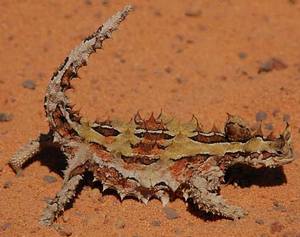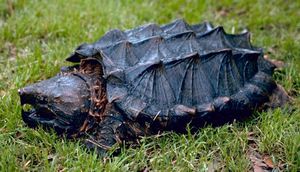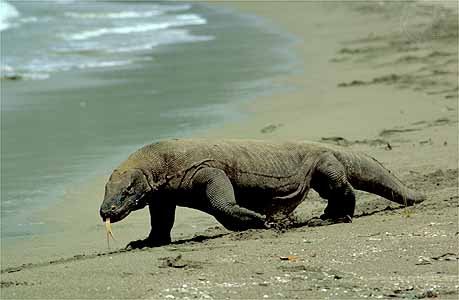Thorny devil

Habitat
It inhabits arid scrub and desert over most of central Australia In particular, it inhabits spinifex-sandplain and sandridge desert within the interior and mallee belt. Its distribution largely coincides more with the distribution of sandy and sandy loam soils than with a particular climate in western Australia.
The food that the devil mainly eats is ants . They can eat some thousands of ants in one day. They collect moisture in the dry desert via night-time condensation of dew which forms on the skin and is channelled to the mouth in hygroscopic grooves between its spines . During rain events, capillary action allows the lizard to suck in water from all over its body.
.Breeding The Thorny Devil mates between September and January (spring and summer in Australia). After mating, the female lizard lays a clutch of between 3 and 10 eggs, which hatch after about three or four months. The hatchlings are sexually mature at around three years of age.
Life span
A thorny devil's life span is about 20 years.
Alligator Snapping Turtle

Habitat
The largest freshwater turtle in North America, the alligator snapper keeps to primarily southern U.S. waters, while the smaller, more aggressive common snaper inhabits lakes and streams from South America to Canada. These turtles can remain submerged for three hours. Typically only nesting females will venture onto open land.
Diet
Alligator snappers are opportunistic carnivores more often at a young age, but are also scavengers. In northern states such as Michigan young hatchlings will live off of plants also, such as water lettuce and other floating grass, shrub, and flower-like organisms. They usally obtain this behavior when food is scarce or when it is early in the summer months. As they mature they become omnivores and do not pose a threat to fish populations. Fishermen have glorified the species' ability to catch fish and to deplete fish populations. Minnows are usually the main source of meat for the species at a young age. They will eat almost anything they can catch. Their natural diet consists primarily of fish and dead fish carcasses (usually thrown overboard by fishermen),invertabrates, carrion, and amphibians, but they are also known to eat snakes, and even other turtles. In captivity they may consume almost any kind of meat provided, including beef, chicken and pork although these are not always healthy on a day to day basis. Though not a primary food source for them, adult Alligator snappers have been known to kill and eat small alligators that have been confined with, such as in a net, small bog, or poorly-planned aquarium display
Breeding
Mating takes place yearly; early spring in the southern part of their total range, and later spring in the north. The female builds a nest and lays a clutch of 10-50 eggs about 2 months later. The sex of the baby alligator snapping turtles depends on the temperature at which the eggs are incubated. Nests are typically excavated at least 50 yards from the water's edge to prevent them from being flooded and drowned. Incubation takes from 100 to 140 days, and hatchlings emerge in the early fall.
Lifespan
Python
The largest freshwater turtle in North America, the alligator snapper keeps to primarily southern U.S. waters, while the smaller, more aggressive common snaper inhabits lakes and streams from South America to Canada. These turtles can remain submerged for three hours. Typically only nesting females will venture onto open land.
Diet
Alligator snappers are opportunistic carnivores more often at a young age, but are also scavengers. In northern states such as Michigan young hatchlings will live off of plants also, such as water lettuce and other floating grass, shrub, and flower-like organisms. They usally obtain this behavior when food is scarce or when it is early in the summer months. As they mature they become omnivores and do not pose a threat to fish populations. Fishermen have glorified the species' ability to catch fish and to deplete fish populations. Minnows are usually the main source of meat for the species at a young age. They will eat almost anything they can catch. Their natural diet consists primarily of fish and dead fish carcasses (usually thrown overboard by fishermen),invertabrates, carrion, and amphibians, but they are also known to eat snakes, and even other turtles. In captivity they may consume almost any kind of meat provided, including beef, chicken and pork although these are not always healthy on a day to day basis. Though not a primary food source for them, adult Alligator snappers have been known to kill and eat small alligators that have been confined with, such as in a net, small bog, or poorly-planned aquarium display
Breeding
Mating takes place yearly; early spring in the southern part of their total range, and later spring in the north. The female builds a nest and lays a clutch of 10-50 eggs about 2 months later. The sex of the baby alligator snapping turtles depends on the temperature at which the eggs are incubated. Nests are typically excavated at least 50 yards from the water's edge to prevent them from being flooded and drowned. Incubation takes from 100 to 140 days, and hatchlings emerge in the early fall.
Lifespan
Kamodo Dragon

Habitat
The natural habitat of Komodo dragons is extremely harsh by human standards. These arid volcanic islands have steep slopes and little available water most of the year. A short monsoon season often produces local flooding. The average annual temperature at sea level on Komodo island is 80F. degrees. Dragons are most abundant in the lower arid forest and savannah.
Komodo dragons mate in late June or July. During this period, males may come into conflict with each other as they defend their territories.
baby Komodo Dragon
Breeding
Five weeks after mating, the female digs a hole in the warm, moist earth and an average of a dozen eggs. The exact number and size of the eggs she lays vary depending on the age and size of the female. She then covers them and leaves them to incubate unattended, relying on the sum to keep them at the proper temperature.
The young dragons hatch eight months later. Barely eight inches long, they are in danger of being eaten by almost every predator on the islands, from snakes and birds of prey to larger Komodo dragons. Those that survive grow quickly, and after five years, they will have reached six feet in length. Both males and females are mature enough to breed at around six years of age.
Life span